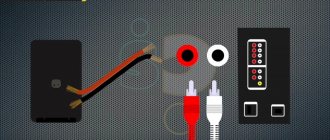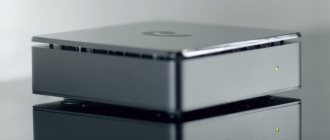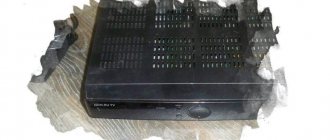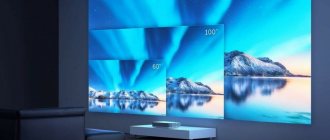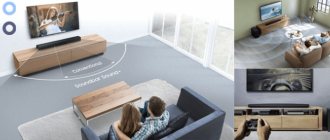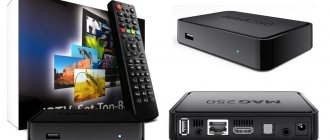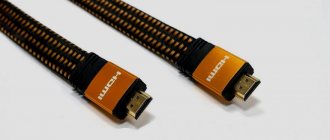What is HDMI on TV
Hdmi is a technology that allows you to transmit multi-channel audio as well as video data in HD format at high speed. Many well-known companies are working on its development: Sony, Phillips, Hitachi, Thomson, etc. In addition, the interface is equipped with copy protection for transmitted data and, in addition to sound and image, can transmit an Ethernet signal, as well as control commands.
An HDMI cable consists of 19 wires. The digital signal is transmitted without compression over this cable at a speed of 4.9 Gbps. In addition, there is no need to transmit a separate audio signal, as was the case with analog data transmission. Thus, you can connect any equipment if you have the appropriate connectors for high-speed digital transmission of audio and video.
Why might such a connector be needed on a TV? Modern TVs are no longer just a device for watching TV shows and movies. Smart functions have significantly expanded their capabilities. Having a large number of outputs, including an HDMI port, has become a necessity. Let's figure out why you need hdmi on a TV.
The name hdmi means that this interface is a high-definition multimedia interface. You can connect a computer, laptop and many other devices to the TV and use it instead of a monitor. After all, a TV screen is larger than a PC monitor. Therefore, watching a movie or playing becomes much more convenient.
Versions
Version
Date of issue
Description
New mandatory Side-by-Side and Top-and-Bottom modes for broadcast content, in addition to the modes available in the 1.4 specification.
Required 3D formats:
- For movies (Blu-ray)
- Frame Packing
- 1080p @ 23.98/24 Hz
- For games
- Frame Packing
- 720p @ 50 or 59.94/60 Hz
- For television
- Side-by-Side Horizontal
- 1080i @ 50 or 59.94/60 Hz
Top-and-Bottom720p @ 50 or 59.94/60 Hz1080p @ 23.97/24 Hz
To use 3D formats, displays must support the required formats. Switches and hubs must pass mandatory formats. Sources (Blu-ray players, game consoles, TV tuners) must support at least one required format.
How to choose an HDMI cable for TV
In order to choose a suitable cord, you first need to understand what length is needed. The standard provides for wire lengths from 0.75 to 10 meters. But if necessary, it can be extended using repeater amplifiers. Moreover, the longer you plan to use the cord, the thicker it should be. But the recommended length should not exceed 3 meters. The HDMI connector looks similar to USB, but with beveled corners. Take a closer look at your equipment, you may find several such ports. Before connecting devices, you need to find out which HDMI protocol your device supports.
The quality of the transmitted signal will depend not only on the length of the cable, but also on the material from which it is made. There are different cable specifications that have different bandwidths and other characteristics, which will be described below. At this stage, you should know what quality and volume of information is expected to be transmitted.
If your TV does not have high specifications, there is no point in purchasing a cable designed to transmit very “heavy” video
Another advantage of this technology is its low cost. But manufacturers go to various lengths to increase the price of the cable. This may be the presence of ferrite rings, gold-plated contacts or gold foil shielding, which provide optimal transmission quality and protect against interference. However, the most ordinary cable and a cord with such additions will perform their functions equally, which is why there is no need to purchase excessively supplemented cables.
Illustrative examples
Next, I will give a clear example of a sophisticated, marketing-packaged product (see image) with a bunch of bells and whistles.
To understand what’s what, we’ll start from the opposite or from the main moves of smart and cunning marketers, and they tell us that we need to buy HDMI cables:
- Shielded with gold foil or other alloy;
- With gold plated contacts;
- With ferrite rings on the side of each connector;
- With additional braid.
Let's go point by point.
HDMI classification and types
The cable structure consists of:
- outer shell;
- braid or screen with copper conductors without insulation for soldering;
- another foil screen;
- shells made of polypropylene;
- shielded twisted pairs for information transmission;
- unshielded twisted pairs for SDA SCL signals;
- other conductive elements for power and control signals.
There are such concepts as protocol and Hdmi cable. A protocol is the rules by which data is transmitted from a source to a receiver. New protocol versions are constantly being released and, since 2002, there are already more than a dozen of them, from 1.0 to 2.1. Now they are released without numbering, so as not to confuse users. What’s good is that all versions are backward compatible, that is, the new ones, although they have more functions, interact perfectly with earlier versions.
To support protocols, there are the following types of cable:
- Standard. Not suitable for very demanding equipment. Supports resolutions of 720p and up to 1080i at 60Hz. With a transfer rate of no higher than 4.9 Gbit/s, color depth 24 bits.
- High Speed. Supports 2160p resolution at 30 Hz, can transmit 3D in Full HD, has a throughput of 8.16 to 10.2 Gbps, and a color depth of 48 bits.
- Premium High Speed. Can transmit data with ultra-HD (4K) resolution, 60 Hz frequency. 3D is also transmitted in ultra-quality. Speed – 18 Gbit/sec.
- Ultra High Speed. Supports resolutions up to 8K. Currently, the maximum data transfer speed is 48 Gbit/s, supporting all technology protocols.
- Standard Automotive Cable – designed for use in vehicles.
The name of the cable may contain Ethernet, which means you can use it to establish a connection to the Internet
The types of connectors can also be different, divided into the following types:
- A. Full-size HDMI, most commonly found in large appliances, is 19-pin and can handle single-link DVI-D.
- V. 29-pin. Compatible with dual-channel DVI-D and practically not used in everyday life.
- C or miniHDMI. Suitable for many portable devices.
- D or microHDMI. It is even smaller in size than the previous type. Also used in portable equipment.
- E or automobile. It has an additional locking connector that prevents separation from vibration, and a shell to protect it from moisture and dust.
There are cables for connecting devices with the following connectors:
- HDMI-HDMI. Optimal connection to TV or home theater from other sources of multimedia content: the best quality of transmitted information.
- HDMI-MicroHDMI and HDMI-MiniHDMI. An excellent solution for transferring data from small devices: tablets, phones, etc. on a large screen with the ability to view in ultra-quality.
- MiniHDMI-MiniHDMI. Capable of transmitting data in 720p, 1080i and 1080. Bandwidth is limited to 10 Gbps.
- HDMI-DVI. Used if one of the devices has an older DVI technology input. Typically used when you need to display an image from a PC or laptop on a TV screen.
When connecting two devices, one of them will work as an input, and the other as an output (out). And you will need to enable the appropriate signal reception mode. We will consider the more detailed connection and configuration of this cable further.
Specific ports for specific functions
When it comes to choosing which HDMI port to use for any device, there are just a few simple things to keep in mind. First of all, when in doubt, always consult your device's manual. Not only may you find that the shared "HDMI 2" port has additional functionality, but you'll also find out that you need to change a setting somewhere in the TV's settings menu to enable it.
The second thing to keep in mind is that for older HDMI devices, such as your old Blu-ray player or cable box, any HDMI port will work thanks to backwards compatibility, but some ports offer additional features, which we'll cover in next section.
Finally, while any port will do the job of serving older HDMI-capable devices, you should be absolutely sure you're using the best port on your HDTV if you have a new input-capable device. If you connect a new device to the old port, you will lose a lot of image quality.
Connecting and setting up an HDMI cable
To connect two devices, for example, a TV and a laptop, the equipment must be turned off. The HDMI cable must be connected to the HDMI connector of the laptop and to the HDMI input of the TV. Now turn on the devices. By the blinking of the TV screen, you can understand that it has determined the desired connection with an external source. The TV will need to be set to AVI mode and select the input to which the cables are connected (since there can be several HDMI ports).
Now you need to configure the image on the source device. To do this, you need to find “Screen Resolution” (the menu may vary depending on the operating system) and set the appropriate value. If the connected TV is not automatically detected, you will need to click “Find” in the screen settings, after which the connected device should be found. Now we need to determine which screen is the main one and which is the secondary one.
If it suddenly turns out that the TV does not transmit sound, then you need to assign it as a device that reproduces sound. To do this, in the notification panel on your PC, where the sound level (speakers) is displayed, you need to select TV in “Playback devices” instead of speakers. The monitor is connected to the laptop in the same way.
HDMI is a very convenient technology that allows you to connect various equipment to transmit audio and video information in high quality without delays. Most often used to display movies or games on a larger screen. The cost of such a cable is low, and setting up connected devices should not be difficult.
Versions
Version
Date of issue
Description
New mandatory Side-by-Side and Top-and-Bottom modes for broadcast content, in addition to the modes available in the 1.4 specification.
Required 3D formats:
- For movies (Blu-ray)
- Frame Packing
- 1080p @ 23.98/24 Hz
- For games
- Frame Packing
- 720p @ 50 or 59.94/60 Hz
- For television
- Side-by-Side Horizontal
- 1080i @ 50 or 59.94/60 Hz
Top-and-Bottom720p @ 50 or 59.94/60 Hz1080p @ 23.97/24 Hz
To use 3D formats, displays must support the required formats. Switches and hubs must pass mandatory formats. Sources (Blu-ray players, game consoles, TV tuners) must support at least one required format.
Afterword
Well, the topic of components has gotten to you, and now you have become more savvy here too. All you have to do is go to the nearest store and buy the correct HDMI cable without overpaying. So go ahead, go for it!
As always, we are waiting for comments, questions, clarifications and other miscellaneous things.
PS Thanks to team member 25 FRAME PPS for the existence of this article. The article was written partly with an emphasis on what I once read here. You can read it, there is a little more information about cable testing, etc. Well, for those who do not trust our conclusions and arguments 
Why is ARC needed?
The ARC data transfer protocol is quite often ignored by users, although most modern AV devices support it.
First of all, you need to understand the essence of ARC: this technology allows you to send sound from your TV to a connected soundbar, set-top box or receiver. Thus, ARC creates a two-way communication channel between the TV and another device. This is convenient, since there is no need to use optical and other cables in the system, which get on the nerves of many. In other words, ARC is a wire killer.
